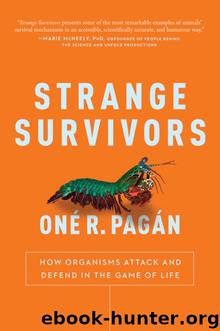Strange Survivors by One R. Pagan

Author:One R. Pagan [Pagán Oné R.]
Language: eng
Format: epub
ISBN: 9781944648596
Publisher: BenBella Books, Inc.
BIOLOGICAL BALLISTICS
Biological organisms are made of matter, and are therefore subject to the rules of physics and chemistry. We must obey the universe’s physical laws, meaning, among many other things, that we cannot travel faster than light, that gravitational fields give our mass the impression of weight, and that the energy we can carry and transfer at any given time depends on how fast we are moving. This last one is best known as Newton’s* second law of motion, which essentially means that the force that any given amount of matter can exert depends on the rate of movement per unit of time; in other words, its acceleration. In short, the heavier an object is, and the faster it goes, the greater the punch it can deliver.
A consequence of Isaac Newton’s second law is that deceptively small objects that carry a lot of energy can cause a lot of damage, if they are moving fast enough. A bullet, for example, is not a very heavy object, as an average bullet weighs about eight grams (about one-third of an ounce).** This is not a lot of weight. And yet, without going into too much detail, even such a small piece of metal can be lethal because of the acceleration imparted by the ignition of a certain amount of gunpowder. Or think about the asteroid or comet that signaled the end of the dinosaur era (briefly mentioned earlier in this book). This big rock that crashed on our planet was about six miles long (think about this: a car moving at sixty miles per hour takes six minutes to cover six miles). Sure, that is big by human standards, but to get a real perspective of its size compared to the Earth’s, just look at a world globe or a world map and figure out approximately how much surface area anything six miles long would cover. In fact, it covers a minute fraction, almost invisible. Surprised? Yes, from this planetary perspective, that rock was a rather small object indeed, a mere pebble compared to the size of our planet. However, that “mere pebble” fell on us at a speed of about forty thousand miles per hour! That cosmic piece of dust triggered a series of events that changed the Earth and its biosphere forever. That rock packed such a punch that today—sixty-five million years after the event—there are still traces of the crater that it left on Earth.*
Seemingly small things can indeed amount to quite a lot depending on the specific situation; one factor is how fast they are moving, which influences how much power is released in a certain period of time. And this does not apply just to planetary events or other non-living systems. Biology has for the longest time excelled at applied physics; there is no question about that. Many organisms have evolved strategies to take full advantage of our physical world. Not surprisingly, most of the activities that reflect these strategies directly contribute to the undertakings that we
Download
This site does not store any files on its server. We only index and link to content provided by other sites. Please contact the content providers to delete copyright contents if any and email us, we'll remove relevant links or contents immediately.
Sapiens: A Brief History of Humankind by Yuval Noah Harari(14320)
The Tidewater Tales by John Barth(12626)
Mastermind: How to Think Like Sherlock Holmes by Maria Konnikova(7278)
Do No Harm Stories of Life, Death and Brain Surgery by Henry Marsh(6905)
The Thirst by Nesbo Jo(6877)
Why We Sleep: Unlocking the Power of Sleep and Dreams by Matthew Walker(6655)
Life 3.0: Being Human in the Age of Artificial Intelligence by Tegmark Max(5516)
Sapiens by Yuval Noah Harari(5322)
The Longevity Diet by Valter Longo(5040)
The Body: A Guide for Occupants by Bill Bryson(5027)
The Rules Do Not Apply by Ariel Levy(4910)
The Immortal Life of Henrietta Lacks by Rebecca Skloot(4550)
Animal Frequency by Melissa Alvarez(4427)
Why We Sleep by Matthew Walker(4394)
The Hacking of the American Mind by Robert H. Lustig(4338)
Yoga Anatomy by Kaminoff Leslie(4332)
All Creatures Great and Small by James Herriot(4271)
Double Down (Diary of a Wimpy Kid Book 11) by Jeff Kinney(4240)
Embedded Programming with Modern C++ Cookbook by Igor Viarheichyk(4141)
